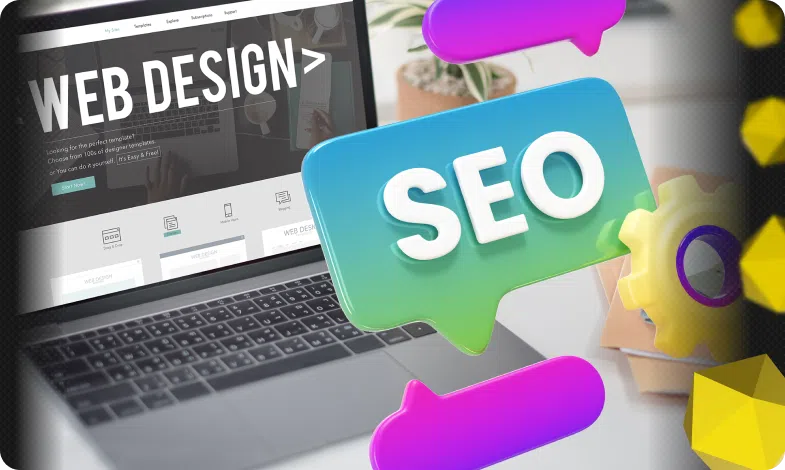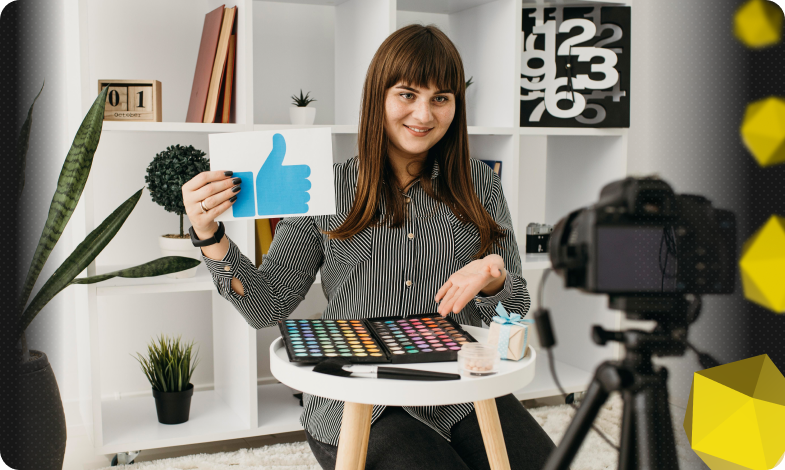Content of the article

Design is the main visual business card of any website. WEDEX will tell you how design affects SEO and what you should pay attention to.
Web and SEO: what’s the connection?
Search engines crawl all the sites available on the web to find out if they are relevant to a particular topic. When Google realizes which category a web resource or a particular page belongs to, it will start recommending it to users.
To help the crawlers, we use SEO: a set of free tools that allow us to explain to the search robots what kind of site or page they are looking at in more detail. These tools include meta tags, media file optimization, keyword optimization, and many other tools.
At first glance, it may seem that all SEO optimization lies in the area with which the user does not interact directly – most site visitors are unlikely to check the title and description first. But, as it turns out, it’s not that simple.
Search engines not only crawl a page for keywords, link database, or meta tags. Google also has other metrics for websites, for example:
- download speed;
- time spent by a user on a website or a specific page;
- user interaction with a particular element of a web resource.
And it is at this point that it becomes clear that SEO is directly related to design and web development, because the above metrics have a significant impact on online rankings. Let’s try to understand in more detail how the design and speed of a website affect its SEO optimization
What are the main goals for website development
Every website exists for something. One is designed to sell goods and is an e-commerce site, while the other is a classic blog. What unites these and any other areas for which a web resource and its design are developed? The answer is: specific goals.
The vast majority of websites have a specific goal, and everything else is adjusted to it. From the ranking system to the forms of communication, everything is subordinated to the original purpose of the site. Here are some examples of goals:
- Sales. These include most of the existing online stores and even single-page websites with a quick order of one product. The design of such resources is characterized by the presence of product cards, shopping carts, connected payment systems, and e-mail newsletters for regular users.
- Collecting leads. Such resources are created in order to obtain user contacts for further interaction. For example: websites of services, consulting, clinics, construction companies. Usually, the design includes feedback forms, «Request a consultation» buttons, and sometimes free materials in exchange for an e-mail.
- User support. A support site unexpectedly supports the user by providing some data. Such resources are a repository for service information, knowledge bases, etc. They have a corresponding design – something like a reference book.
There are many more goals, but each of them has its own specific design and style, which allows the user to immediately guess what kind of resource is in front of him.
Order website development and web design from WEDEX! We will create a modern, functional web resource for you, taking into account your company's goals, user convenience, and search engine requirements.Need a well-designed website that helps you achieve your business goals?
A distinctive design is the first hook for any user, which will explain the feasibility of using this particular site in the language of associations.
Website design: UX and its impact
User Experience is a component of web design that aims to create not only a useful but also a user-friendly website. The UX component of any design is an important part of SEO, because it is the clarity of the interface design and the importance of the information available that will help the user decide whether to stay on the site or not.
Yes, UX is usually referred to:
- Information architecture. The site should have a clear structure of information distribution. If the resource is a reference one, it is necessary to develop a design that allows you to easily navigate a large amount of text. The design of an online store should be focused on cards and quick browsing of products. The designer should not only consider how beautiful the site looks, but also how easy it is for the user to navigate and find what they need.
- Design of the resource. Any multicolored website with an excess of visual design effects will lose out to a «gray» website that has convenient navigation with specific sections. Therefore, to have a really good design that meets your goals, you should maintain a unity of style. For example, the design of a landing page for selling a single type of dog food will be very different from the electronic version of a magazine.
- Content. If design is the first thing that catches the eye, content is the part about «taking you to the bank». Search robots carefully study not only the semantics of texts but also the real benefits of content for the user. A well-structured content filled with various links and optimized for search will have a great advantage among similar sites for the search engine.
All three points are an integral part of a really good UX. If one of these areas falls short, it’s likely that Google will start penalizing the site and ranking it worse.
Basic requirements for website design: not only front, but also back
Good design is only a part of the iceberg called usability. This term explains how comfortable a user is with a web resource, how user-friendly the interface is, etc. In general, there are several basic requirements for website design so that it meets the principles of usability for the majority of potential customers.
- The importance of optimal page weight. Have you ever thought about how much a page on your website weighs? This is one of the most important indicators for search engines. The heavier the page, the longer it will take for the browser to render it on the user’s device, which means that it will take the user more time to scroll through the pages. Google ranks sites with long loads worse (long loads are those that take more than 2-3 seconds before the main body of content appears on a desktop and 3-4 seconds on a smartphone).
- Cleanliness of the website’s source code. Design is not only what the client sees, but also the entire «inside» of the pages: scripts, APIs, databases. Usually, websites that have overloaded code also load worse and take longer, which directly affects SEO. This is not a direct requirement for the designer, but rather for the programmer: the first priority is to ensure that all internal components work quickly and accurately.
- Availability of site search. Almost any website should be equipped with an internal search. This way, the user can quickly find the necessary information among the content or product. The availability of search is a plus for SEO optimization of the resource.
- Clear navigation. As we mentioned above, to improve SEO, a website should have clear and convenient navigation through all sections, pages, blogs, etc. This way the user will be able to find anything, including the necessary information, even in the most unusual design.
- Menu design: both header and footer. The presence of a menu in both the header and footer of the site is not only an example of good taste for the developer, but also user convenience. It is also a good idea to install buttons to quickly return to the main page or the beginning of the current page.
- Editing all content. Yes, most of the content is text, but there is also media and embedded content such as video and music players. All content on the page and website should be relevant, clearly structured, and SEO-optimized. Keywords, meta tags, and alt attributes for images should be used appropriately.
As you can see from the list, the first two points directly depend on how the site works on the server side.
How do search engines scan website design?
Search engines don’t evaluate website design like we do – they don’t have eyes and senses, but they do rely on specific data. For example, Google can make a conclusion about the quality of design and its impact on SEO by:
- website traffic – how often users visit the site and return to it after a while;
- browsing depth – how far a user can go while navigating the site’s pages, which directly depends on the quality of SEO and design convenience;
- time spent on the page and interaction – how much time the user spends studying articles, ordering products, etc.
Search engines use these parameters to determine the trustworthiness of a website. The higher the trust, the more likely the site is to be at the top of search queries.
It is worth noting that it is most difficult to gain trust with a newly created website. They do not yet contain a link database, views are just beginning to accumulate, and many users either bypass it or choose more trusted resources. Google places such sites in the so-called «sandbox», where the resource will remain until the core audience is formed. As soon as the resource gains enough trust points, any possible suspicions on the part of Google will be exhausted.
The main factors of search engine trust:
- uniqueness of design and non-use of template patterns;
- age of the site (the older the better);
- the presence of users who actively interact with the website;
- the presence of links to the site from other resources, especially from advertising offices, directories, and simply resources that refer to the site as a source;
- availability of real contact information and official registration of the entrepreneur (for shops).
Mobile versions of websites
One of the most important aspects of design’s influence on SEO is the availability of a mobile version of a resource. The modern Internet is built around mobile devices, as more than half of the queries come from them. Therefore, having a well-functioning mobile version with a high-quality design is extremely important for SEO and rankings.
The approach in which the main focus is on the mobile version of the resource is called Mobile-first. This approach is based on the fact that a mobile version is developed first for a web resource, which is only later finalized to a full-fledged desktop version.
But today, many developers follow the old approach: desktop first, then everything else. It is impossible to say for sure which of these approaches is more correct. The only sure thing is that for better SEO and ranking, a website should have a mobile version. How exactly will it be made? This is another question, the main thing is that it should work properly and encourage users.
The problem of creating a mobile version is solved by adaptive layout. Website builders such as WordPress, Framer, Weblium, and Webflow support this mode, allowing you to quickly adapt desktop versions to mobile ones.
Requirements for mobile versions
The design requirements for mobile and desktop versions are generally similar, but have some nuances:
- All important elements of the page should be adapted to the design of the mobile version, i.e. video player, text width and visibility, images with alt.
- The structure of the versions should be the same and equally obvious (it is clear that it is impossible to create the same header due to the smaller screen, but the menu should be convenient).
- Version meta tags must match.
- It’s important to use the rel=”caninocal” tag to indicate the link between versions of pages.
- The server that contains the mobile version must withstand a heavy load when search engines crawl pages.
But that’s not all. Google also puts forward an additional requirement for mobile pages: the absence of a large number of banners and ads that interfere with the viewing of the main content. Often, websites that contain such ads are labeled as unreliable, and their rankings are significantly deteriorated.
Conclusions
To summarize, here are the main signs that website design can help improve SEO:
- Visual style: the eyes of a potential customer are not bothered by excessive effects, banners, and advertising. The design is consistent, but not ascetic. It is the same for all pages.
- Content: not only useful, but also well-presented and structured.
- Mobile version: stable operation that meets Google’s requirements.
- Clarity: navigation is easy, all sections have a logical structure.
- Correctly designed technical pages: site map, 404 or other code errors, redirect, registration, order notifications, etc.
- Availability of standardized pages: “About Us, Home, Testimonials, Blog, or News. These are time-tested headings that should not be changed unless necessary.






 17/06/2025
17/06/2025  1912
1912



